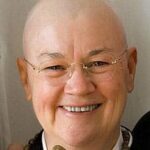A Zen koan that takes on the problematic question of our self-identity on a personal level begins simply with a question.
Zen teacher Goso asked, “Senjo and her soul are separated—which is the true Senjo?” The question is based on a beautiful old Chinese ghost story.
Once, in a village by a river, a girl and a boy, second cousins, grew up together as inseparable companions. They were so close that the girl’s father once joked that they seemed married already. Eventually, they did fall in love. However, the girl’s father announced that she was to marry a different man.
The girl, Senjo, and her sweetheart, Ochu, were devastated, and Ochu was so upset that he decided to take his boat and leave the village. Just as he began to sail down the river, he saw a shadowy figure standing on the riverbank. Senjo stepped into the boat and they escaped down river together.
When we simply allow and acknowledge the deeply felt personal aspect of the self, we can heal.
Five years passed. They had two children and were very happy, except that from time to time Senjo would burst into tears because she missed her family. They decided to return, and when they arrived home, Ochu went up to Senjo’s house to ask forgiveness for leaving with her. Her father seemed surprised, and said, “What? From the day you left, Senjo has been upstairs lying on her bed, looking so sad, and she’s never said a word.”
Just then, Senjo from the boat arrived at the door, and suddenly the Senjo from upstairs appeared, smiling. The two Senjos looked at one another, smiled, and walked right into one another. Instantly, they became one.
So the question is: “Senjo and her soul are separated. Which is the true one?” Senjo might have answered, “I’m not sure which is the real me—the one who married Ochu or the one who stayed with my family and lay sick in bed.”
Your question might be: “Which is the true me, the one trying to fit into this world or the one who is shrinking and fearful, hiding and unexpressed?” Are they one or two?
This story dramatically shows the bringing to life of cast-off parts of the self and the healing gained through integration. When we simply allow and acknowledge the deeply felt personal aspect of the self, we can heal.
This is the interior “self-intimate” piece of who we are. It cannot be ignored. It is the deepest personal experience of who we are, and when we take care of that lost self, like Senjo lying in her bed at home, then we are no longer cut off from our experience and what often drives our daily conduct. Without integrating that self, without that wholeness, we live on the surface, on automatic, not drawing on the wellspring of our life. Goso’s question, “Who is the real Senjo?” can only be answered when we connect to all of our personal self.
Excerpted from “Our Moment of Possibility and Joy.”

